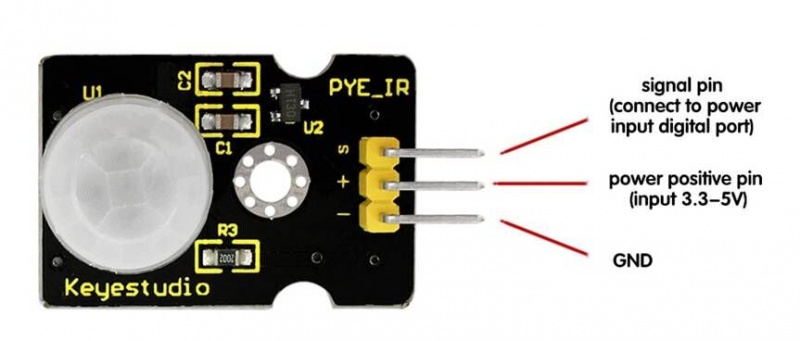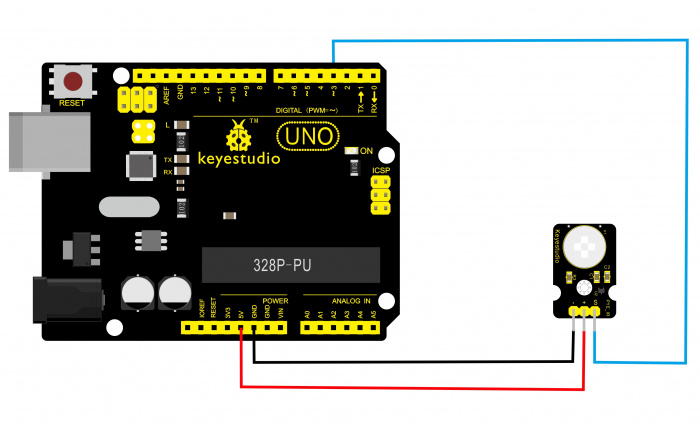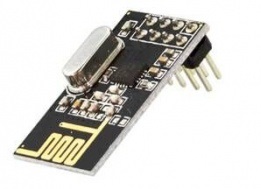Keyestudio NRF24L01 2.4Ghz Wireless Network Module
The Pyroelectric infrared motion sensor detects infrared signals from a moving person or animal and outputs signals. It can be used to detect human body movement in a variety of situations. It is frequently employed in automated lighting and burglar alarm systems. The sensor can accept 3.3V directly from a microcontroller like the ESP8266 or ESP32.
Package Includes:
- 1 x PIR Motion Sensor Module Ks0052 keyestudio
The Pyroelectric infrared motion sensor detects infrared signals from a moving person or animal and outputs signals. It can be used to detect human body movement in a variety of situations. Traditional pyroelectric infrared sensors are larger, with more complicated circuits and lower reliability. This sensor, designed specifically for Arduino, incorporates a digital pyroelectric infrared sensor with connection pins. It offers greater reliability, lower power consumption, and simpler circuitry.
Principle of Work: The PIR sensor measures fluctuations in the amount of infrared radiation impinging on it, depending on the temperature and surface characteristics of the objects in its field of view. When a human walks in front of it, the temperature in the sensor’s view changes from ambient to body temperature and back. This change in infrared radiation is detected, and the sensor outputs a signal. The sensor uses a repeating trigger mechanism, meaning the trigger duration resets every time movement is detected.
Pinout of the Module:

Pin on the PCB | Description
- S | Digital output (HIGH: 3.3V or LOW: 0V)
- Power + | Positive DC power supply (3.3-5V)
- Power - | Ground
Applications:
- Intruder alarms
- Entryway lighting
- Security lighting
- Hand dryers
- Automatic doors
Circuit: Connect the module's S pin to Digital 3 on the UNO board, the negative pin to the GND port, and the positive pin to the 5V port.

Library: No library is needed to use the module with Arduino.
Code:
byte sensorPin = 3;
byte indicator = 13;
void setup() {
pinMode(sensorPin, INPUT);
pinMode(indicator, OUTPUT);
Serial.begin(9600);
}
void loop() {
byte state = digitalRead(sensorPin);
digitalWrite(indicator, state);
if (state == 1) {
Serial.println("Somebody is in this area!");
} else {
Serial.println("No one!");
}
delay(500);
}
After Code Uploading: After wiring the sensor and uploading the code, when the sensor detects movement, the D13 indicator on the UNO board will light up, and "Somebody is in this area!" will appear on the serial monitor. If no movement is detected, the D13 indicator will remain off, and "No one!" will be displayed on the serial monitor.
Technical Details:
- Voltage: 3.3V~18V
- Static Current: < 15uA
- Logic Output: 3.3V / 0V
- Delay Time: 2s
- Sensing Range: <100°, 3-4 meters
- Temperature: -20 ~ 85°C
- Output Indicator LED: ON when HIGH
- Pin Limit Current: 100mA
- Dimension: 15mm x 15mm x 20mm
Comparisons: The KS0052 sensor is well-suited for projects that require a small footprint. Similar sensors include the SR-602, HC-SR505, and AM312. The SR-505 works with a voltage range of 5-20V, which is good but not ideal for the ESP8266. The AM312 works at a lower voltage (2.7V) and is a better option for low-voltage projects, with an 8-second delay time for longer detection intervals.
